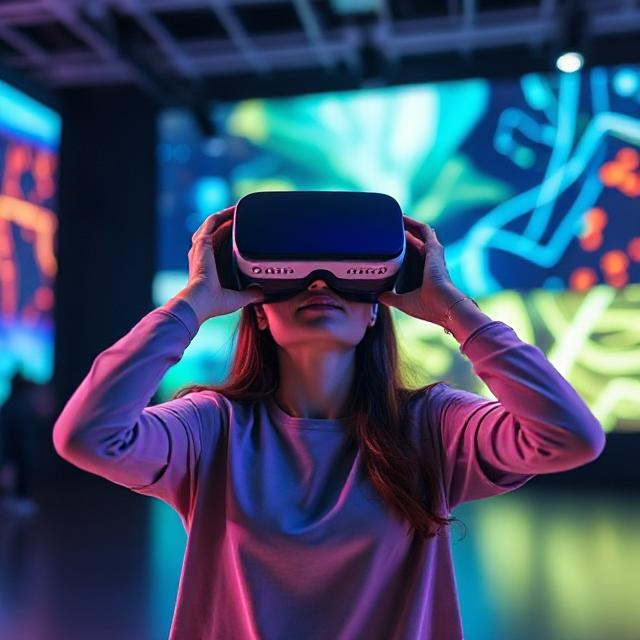How Virtual Reality Can Transform Your Business ?

How Virtual Reality Can Transform Your Business ?
What is Virtual Reality (VR)?
Virtual reality (VR) is a technology that immerses users in a simulated digital environment. By wearing VR headsets or glasses, users can interact with and experience these virtual worlds as if they were real.
While many associate VR with gaming—picture a room full of gamers battling aliens in immersive environments—its applications extend far beyond entertainment. Today, VR is gaining traction across various industries as a powerful enterprise tool.
For example, businesses are using VR to create realistic product demonstrations, turning advertisements into engaging experiences. It’s also being utilized to identify and resolve challenges in architecture and interior design before they arise in the physical world.
As a business owner, you might wonder, “Why should I care about VR?”
The answer is simple: staying competitive means embracing evolving technologies. When used effectively, VR has the potential to revolutionize your operations, enhance efficiency, and drive growth.
The Five Ways VR Can Save You Time and Money
Way #1: Showcase Your Products Worldwide
Imagine you’re a tractor manufacturer who has just launched a new line of products. Traditionally, showcasing your tractors at international trade shows would require significant investment—shipping costs, logistics, and booth setup fees can quickly add up.
But what if you could skip the hassle and expense altogether? With virtual reality (VR), you can create a realistic 3D model of your tractor for a fraction of the cost. This virtual model allows potential customers to explore the tractor from every angle, examine its features, and even see it in action—all in real-time.
By leveraging VR, you can showcase your products at global expos without the need for physical transportation or setup. This not only saves time and money but also expands your reach, enabling you to connect with international audiences effortlessly.
In a world where businesses are increasingly going digital, VR offers an innovative way to exhibit your products and stay ahead of the competition.
Way #2: Create and Test Your Own Product Prototypes
Developing a product from scratch can be a time-consuming and expensive process. From trial runs to reliability testing, businesses often invest thousands of dollars and countless hours to perfect their designs.
Virtual reality (VR) transforms this process by enabling you to create and test detailed virtual prototypes. Using VR, you can analyze your product in-depth during the preproduction and testing phases without the need for physical materials.
One of the biggest advantages of virtual prototyping is the ability to identify and fix issues in real-time. This eliminates the need to build multiple physical models, saving both time and money. Additionally, VR allows you to visualize your product in various environments, under different lighting conditions, and from multiple angles.
This level of detail empowers you to make informed decisions about design elements like colors, materials, and functionality early in the development process. By leveraging VR for prototyping, you can streamline production, reduce costs, and bring higher-quality products to market faster.
Way #3: Use VR to Train and Educate Your Team
If you’re considering training your team in soft skills or other areas, VR offers a far more engaging alternative to traditional methods like screens and projectors. Not only is VR training more cost-effective than conventional approaches, but it also provides deeper, more impactful learning experiences.
VR immerses employees in realistic scenarios where they can practice skills in a safe, controlled environment. This eliminates the risk of real-world consequences, such as conflicts with team members or costly mistakes during training.
Additionally, studies show that VR-trained employees learn up to four times faster than those using e-learning or classroom-based methods. The immersive nature of VR keeps learners engaged and accelerates their ability to retain and apply new knowledge.
By adopting VR for employee training, you can reduce costs, improve learning outcomes, and ensure your team is equipped with the skills they need to succeed—all while minimizing risks and maximizing efficiency.
Way #4: Collaborate Globally with VR
Imagine you want to bring together a group of specialists from around the world to develop a product. While having them all in one room for brainstorming sounds ideal, it’s also incredibly expensive. When you factor in flights, accommodation, transportation, and meals, the costs can quickly reach tens of thousands of dollars.
Enter VR technology. With VR headsets and a collaboration platform, teams from different corners of the globe can meet instantly without the hefty expenses. Everyone can connect, share ideas, and collaborate in real-time from their own workspaces.
Since all participants are working in the same virtual environment on the same model, feedback is shared instantly and more effectively. This not only saves time and money but also enhances productivity and innovation—without anyone needing to leave their desk.
Way #5: Reduce Travel Expenses
Travel costs can consume a significant portion of a company’s budget. However, with VR, you can showcase your products to potential customers using virtual 3D models—no need to travel across states or countries.
For instance, a real estate agent can use VR to give buyers a virtual tour of properties, eliminating the need for repeated in-person visits. Similarly, businesses that rely on meeting high-touch clients can replace face-to-face interactions with immersive VR experiences, saving both time and travel expenses.
One of the greatest advantages of VR communication is that it keeps clients informed about project updates, regardless of their location. By reducing the need for physical travel, VR not only cuts costs but also boosts efficiency and accessibility for everyone involved.





